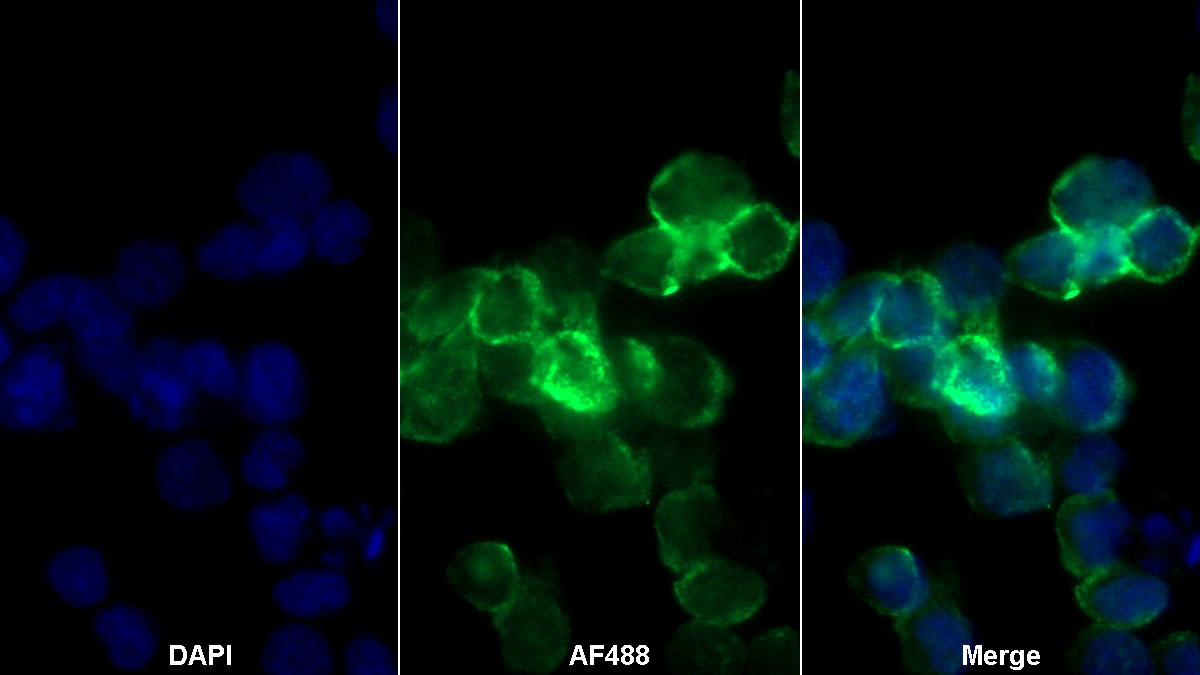Monoclonal Antibody to Octamer Binding Transcription Factor 4 (OCT4) 

POU5F1; OCT3; OTF3; OTF4; Octamer-4; POU Domain Class 5 Transcription Factor 1; POU Class 5 Homoeobox 1; Octamer-binding protein 3
Overview
Properties
- Product No.MAA424Hu23
- Organism SpeciesHomo sapiens (Human) Same name, Different species.
- ApplicationsICC/IF
If the antibody is used in flow cytometry, please check FCM antibodies.
Research use only - Downloadn/a
- CategorySignal transductionDevelopmental science
- SourceMonoclonal antibody preparation, Host Mouse
- Ig Isotype IgG1 Kappa, Clone Number 2#
- PurificationProtein A + Protein G affinity chromatography
- LabelNone
- Immunogen RPA424Hu01-Recombinant Octamer Binding Transcription Factor 4 (OCT4)
- Buffer Formulation0.01M PBS, pH7.4, containing 0.05% Proclin-300, 50% glycerol.
- TraitsLiquid, Concentration 1mg/mL
Sign into your account
Share a new citation as an author
Upload your experimental result
Review

Contact us
Please fill in the blank.
Specifity
The antibody is a mouse monoclonal antibody raised against OCT4. It has been selected for its ability to recognize OCT4 in immunohistochemical staining and western blotting.
Usage
Western blotting: 0.01-2µg/mL;
Immunohistochemistry: 5-20µg/mL;
Immunocytochemistry: 5-20µg/mL;
Optimal working dilutions must be determined by end user.
Storage
Store at 4°C for frequent use. Stored at -20°C in a manual defrost freezer for two year without detectable loss of activity. Avoid repeated freeze-thaw cycles.
Stability
The thermal stability is described by the loss rate. The loss rate was determined by accelerated thermal degradation test, that is, incubate the protein at 37°C for 48h, and no obvious degradation and precipitation were observed. The loss rate is less than 5% within the expiration date under appropriate storage condition.
Giveaways
Increment services
-
 Antibody Labeling Customized Service
Antibody Labeling Customized Service
-
 Protein A/G Purification Column
Protein A/G Purification Column
-
 Staining Solution for Cells and Tissue
Staining Solution for Cells and Tissue
-
 Positive Control for Antibody
Positive Control for Antibody
-
 Tissue/Sections Customized Service
Tissue/Sections Customized Service
-
 Phosphorylated Antibody Customized Service
Phosphorylated Antibody Customized Service
-
 Western Blot (WB) Experiment Service
Western Blot (WB) Experiment Service
-
 Immunohistochemistry (IHC) Experiment Service
Immunohistochemistry (IHC) Experiment Service
-
 Immunocytochemistry (ICC) Experiment Service
Immunocytochemistry (ICC) Experiment Service
-
 Flow Cytometry (FCM) Experiment Service
Flow Cytometry (FCM) Experiment Service
-
 Immunoprecipitation (IP) Experiment Service
Immunoprecipitation (IP) Experiment Service
-
 Immunofluorescence (IF) Experiment Service
Immunofluorescence (IF) Experiment Service
-
 Buffer
Buffer
-
 DAB Chromogen Kit
DAB Chromogen Kit
-
 SABC Kit
SABC Kit
-
 Long-arm Biotin Labeling Kit
Long-arm Biotin Labeling Kit
-
 Real Time PCR Experimental Service
Real Time PCR Experimental Service
Citations
- A universal glucometer-based biosensor for portable and quantitative detection of transcription factorsRsc: Source
- Upregulation of stem cell markers ALDH1A1 and OCT4 as potential biomarkers for the early detection of cervical carcinomaDoi: 10.3892/ol.2018.9381
- Generation of two induced pluripotent stem cell lines NCCSi005A and NCCSi006A from CD4+ T cells of healthy individuals of Indian origin
- Experimental and Modeling Framework for the Production of Cell and Protein-Based Biopharmaceutical Products
- Generation and characterization of three clones (NCCSi007A, NCCSi007B and NCCSi007C) of an integration free induced Pluripotent Stem Cell line from a …Pubmed: 31862609
- Studies on male gonadal toxicity of bisphenol A in diabetic rats: An example of exacerbation effectPubmed:35187753






